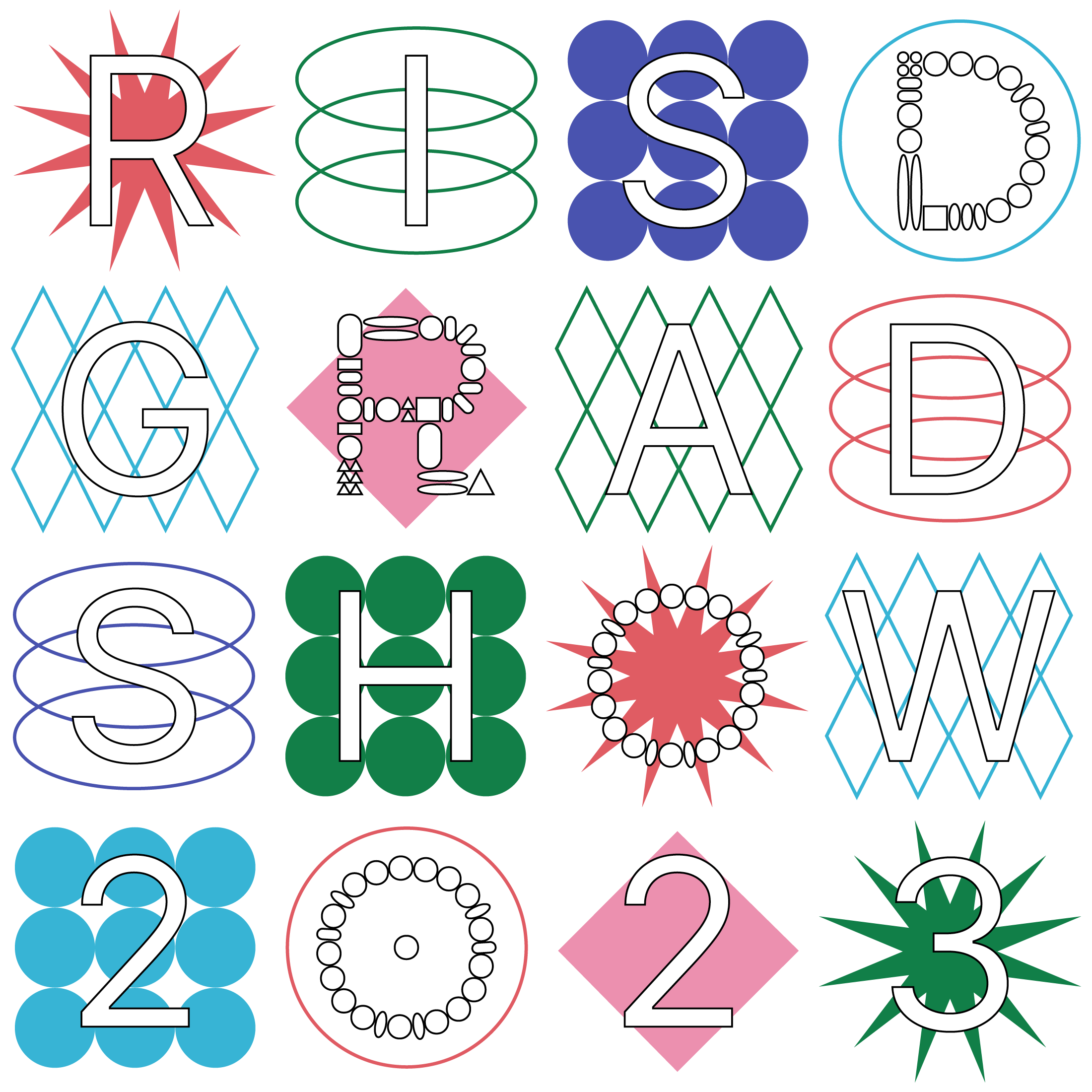Image
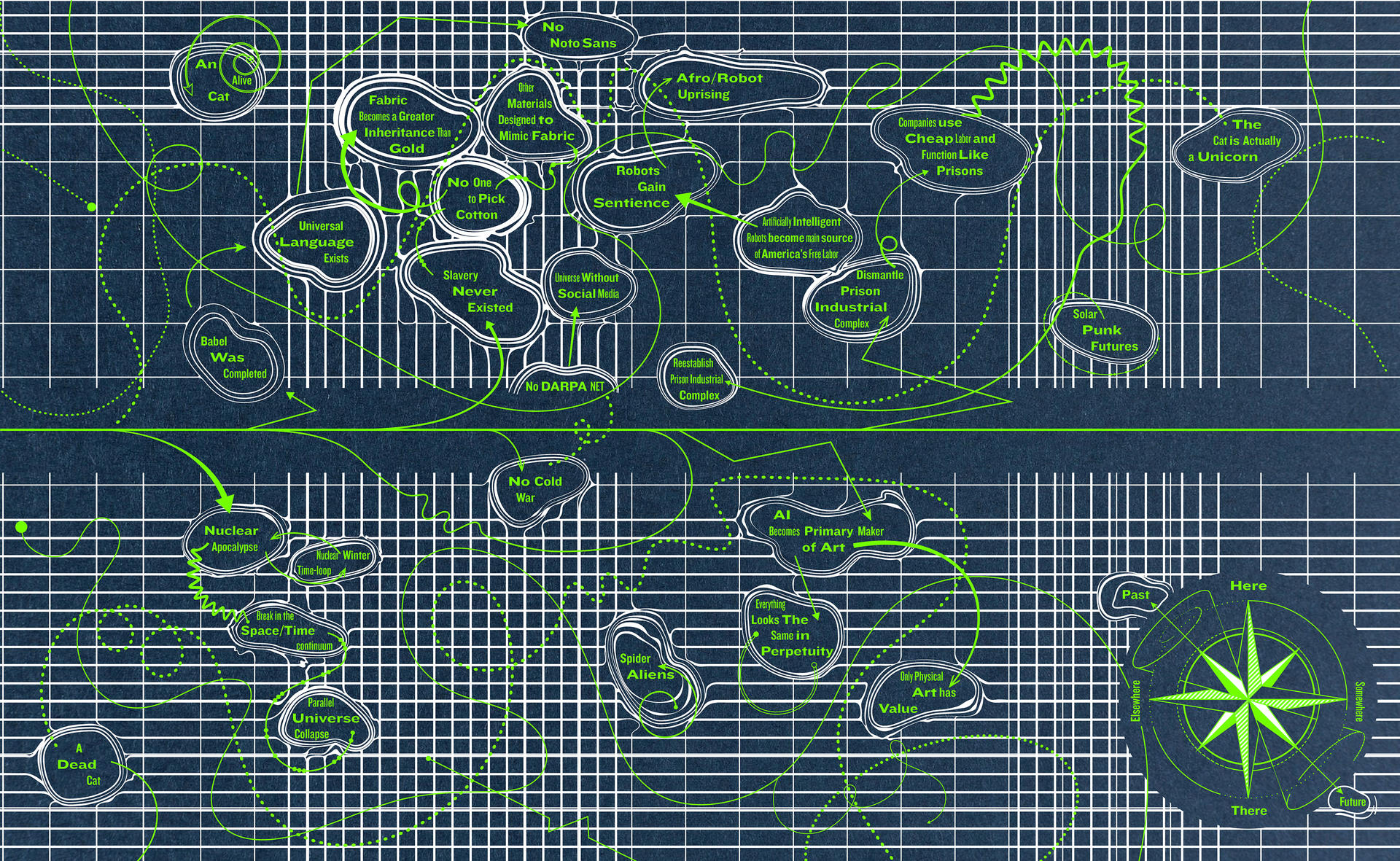
Jenni Oughton
Infinitely Incredible Configurations
As a designer, I am intent on charting out a radically different perspective on the future. To instigate movement beyond current design thinking centered on problem solving, I propose a shift toward design fiction—a deliberate and direct inquiry into the realm where design meets science fiction, and how that merges with reality. My practice uses science, speculative fiction, and technology as positive models to both generate prompts and spur design outcomes. I borrow from the author Isaac Asimov's three categories of science fiction narratives to instigate a way of structuring this design endeavor: What if ..., If only ..., If this continues … and how these questions can ask what “possible societies of the future… might or might not develop” as a result of new designs and technologies. Within this framework I leverage the theory of the quantum multiverse to explore infinite possibilities.
"Infinitely Incredible Configurations" is a rethinking about how we might navigate through the world and transform the power that our voice has in it.
Image

Sacred Timelines
Poster
16" x 26"
2023
I approach design as a practice of hopscotching across “what ifs.” I reorient our timeline, diverting from it at different points in history to envision how that would shape our present, and then designing for those futures rather than our own. The Sacred Timelines is a map exploring all the different alternate realities that shaped the projects in this thesis, and some that never made the cut.
Image
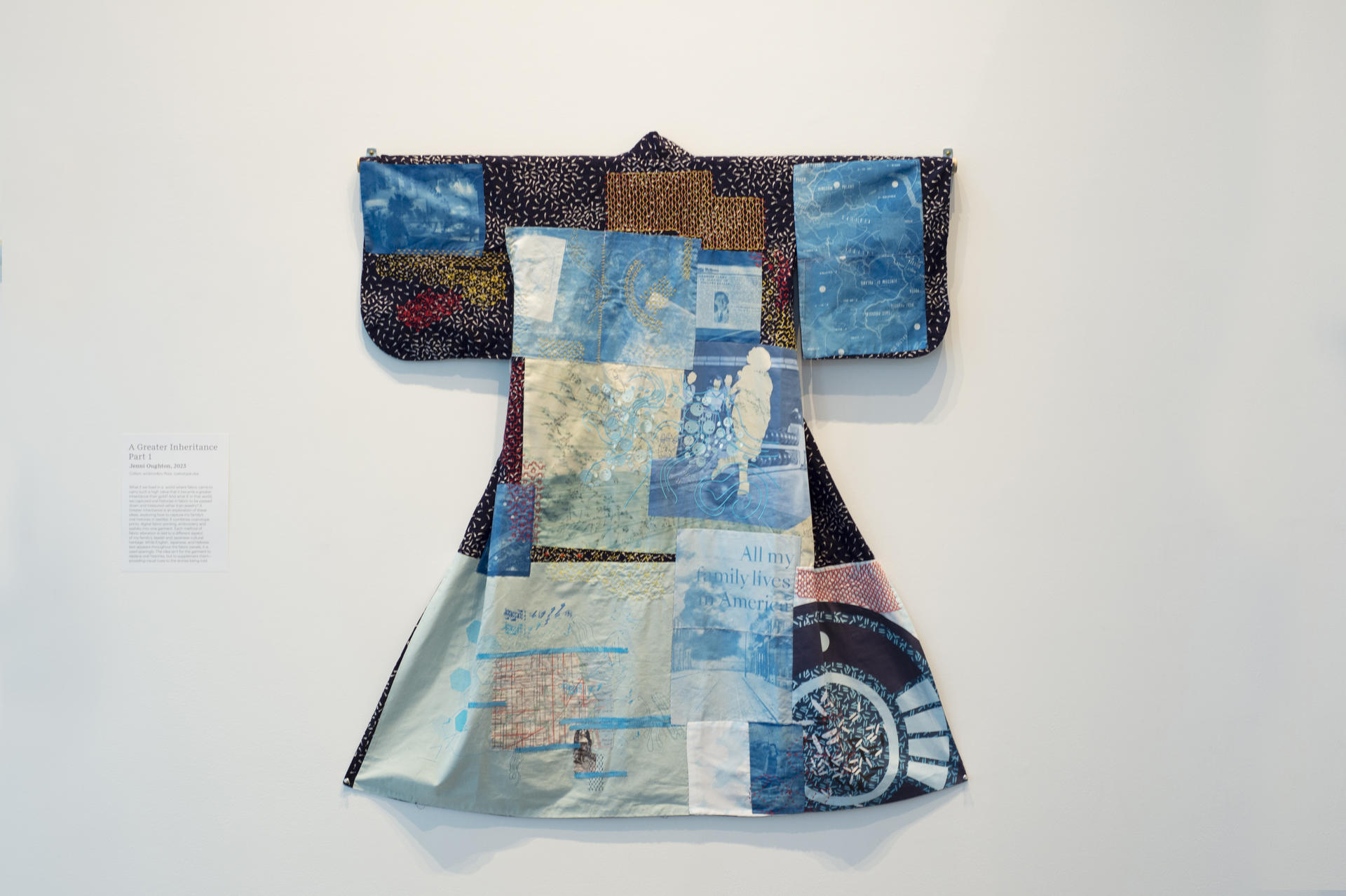
A Greater Inheritance
Cyanotype printed cotton, cotton thread, rayon thread, cotton fabric
4' x 5'
2023
What if slavery didn’t exist? If there wasn’t a source of free labor to pick cotton, did we pick less of it? Did we then have less cloth, less clothing? Would the history archives of that world be filled with the fabrics and clothes held precious? In that world would fabric have come to carry such value that clothes become a greater inheritance than gold?
What if, in that society, we captured oral histories in fabric to be passed down and treasured rather than jewelry? It is from this last question that I began my design inquiry. How could I capture the oral histories of my family in textiles, and what kind of garment would the textiles create.
Image
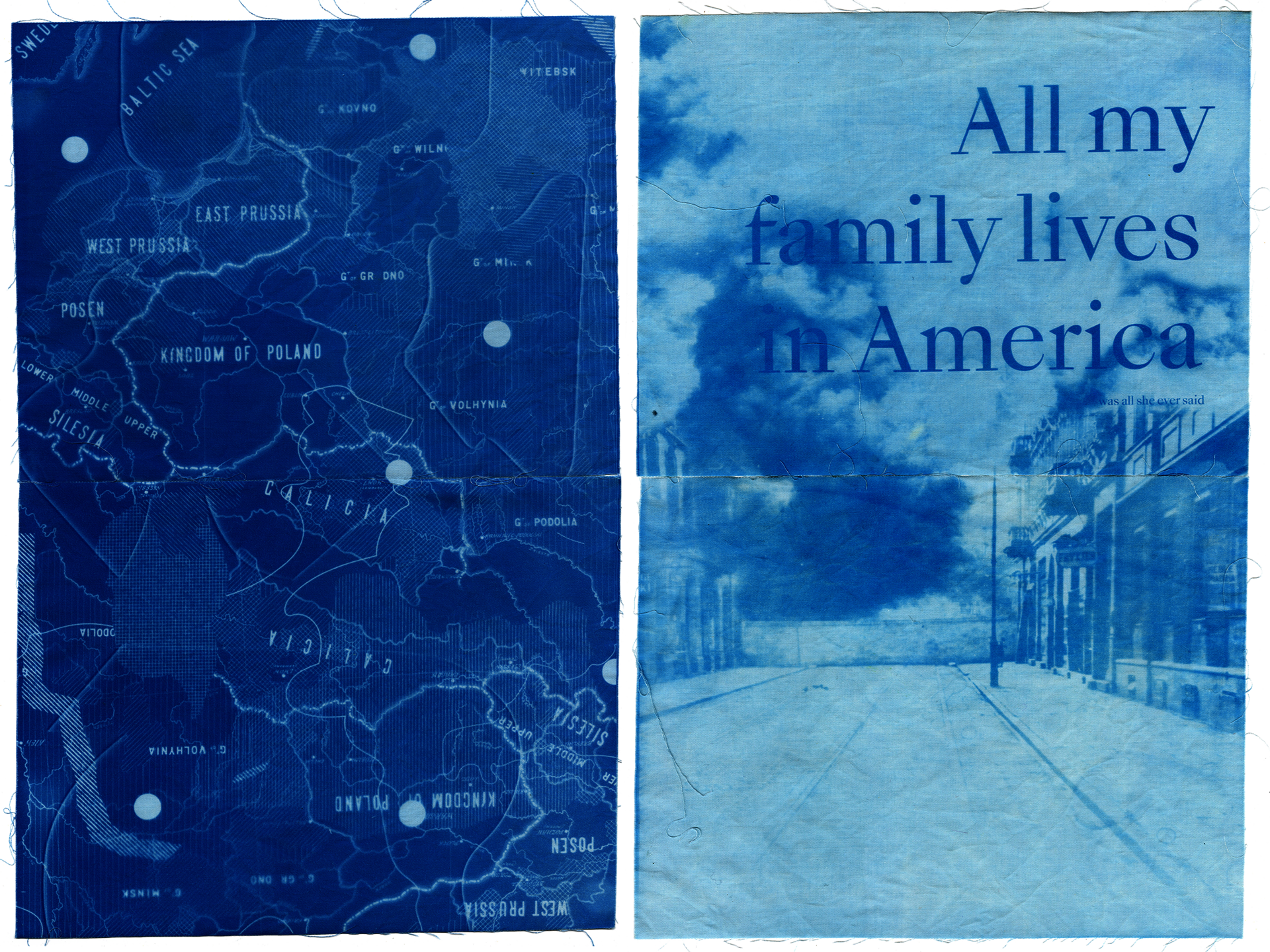
A Greater Inheritance, detail photo
Cyanotype printed cotton
11"x17"
2022
Though embroidery is used throughout the entire garment, I wanted to explore other ways to retell stories across time in fabric. I experimented with different materials and modes of imaged making based on the generation the story originated from. Many of the stories of my great grandparents' generations took the form of cyanotype prints, whereas the tales of my grandmothers were created using more modern digital printing techniques.
Each panel tells a different story from my family's history, exploring a complex story of loss, migration, and found family.
Image
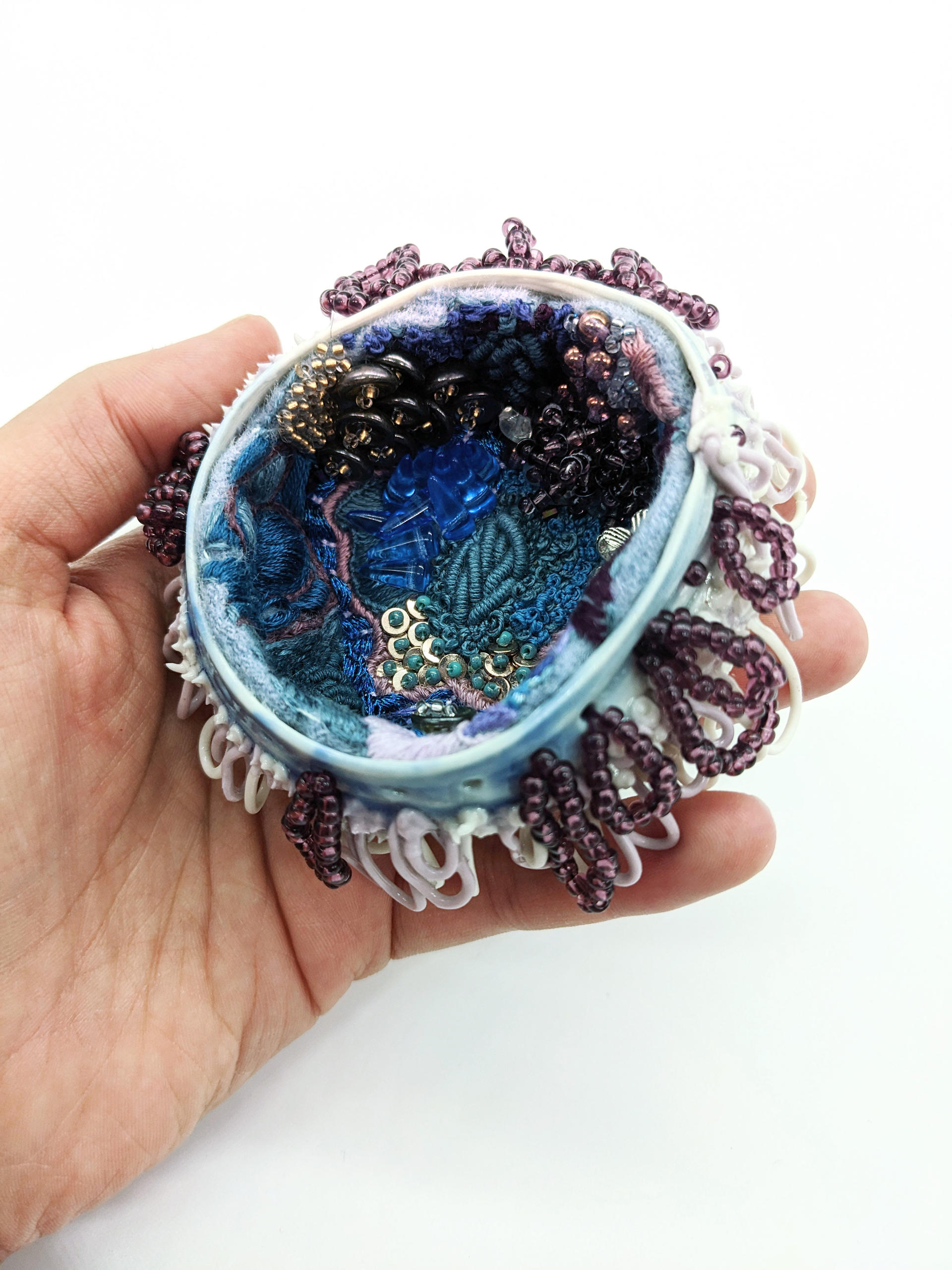
Inheritance Vessel
Porcelain and fiber art sculpture
3" x 3" x 1.5"
2023
If we’re imagining a world where fabric has such a high value and respect, how would that affect other aspects of that world? Would fabric and the motif of threads make its way into other objects and art forms in that world? Experimenting with using porcelain and ceramic 3D printing to emulate the illusion of unraveling threads in clay, I tried to envision what trinkets and small ceramic vessels might look like in this world. These ceramic vessels were then filled with embroideries made from recycled fabric, broken bits of jewelry, and split embroidery thread. They explore how the motifs of what is valued in that world would be expressed in art, while also acknowledging the need to let no bits of thread or fabric go to waste.
Image
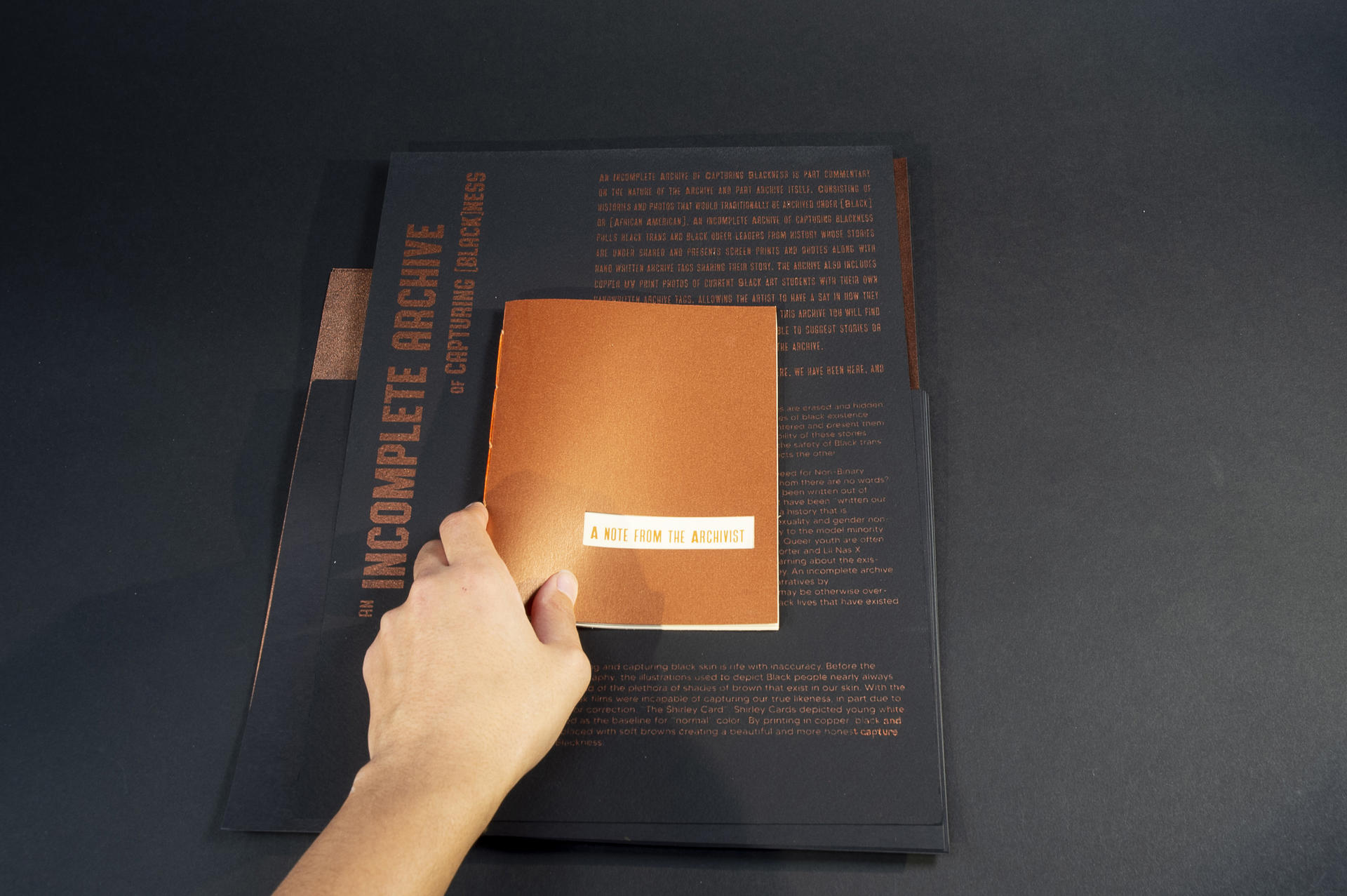
An Incomplete Archive of Capturing [Black]ness
Silkscreen printing, pen plotting, UV printing
2021
This project is both an archive and an ongoing commentary on the nature of archiving, consisting of histories and photos that would be archived under [Black] or [African/American].
This archive is focused on stories that have been “written out” of our traditional narratives of Black History. This history is overwhelmingly told as straight, since homosexuality and gender nonconformity are generally viewed as contradictory to the “model” minority narratives that are highlighted by Black History. Black queer youth are presented with a narrative that shows Billy Porter and Lil Nas X as the first “out” Black queer icons. They are denied learning about the existence of Stormé DeLaurie or Gladys Bentley. An Incomplete Archive of Capturing [Black]ness fights these faulty narratives by capturing snapshots of these “invisible” lives, showing the depth and variety of lives that enrich the fullness of Black History.
Image
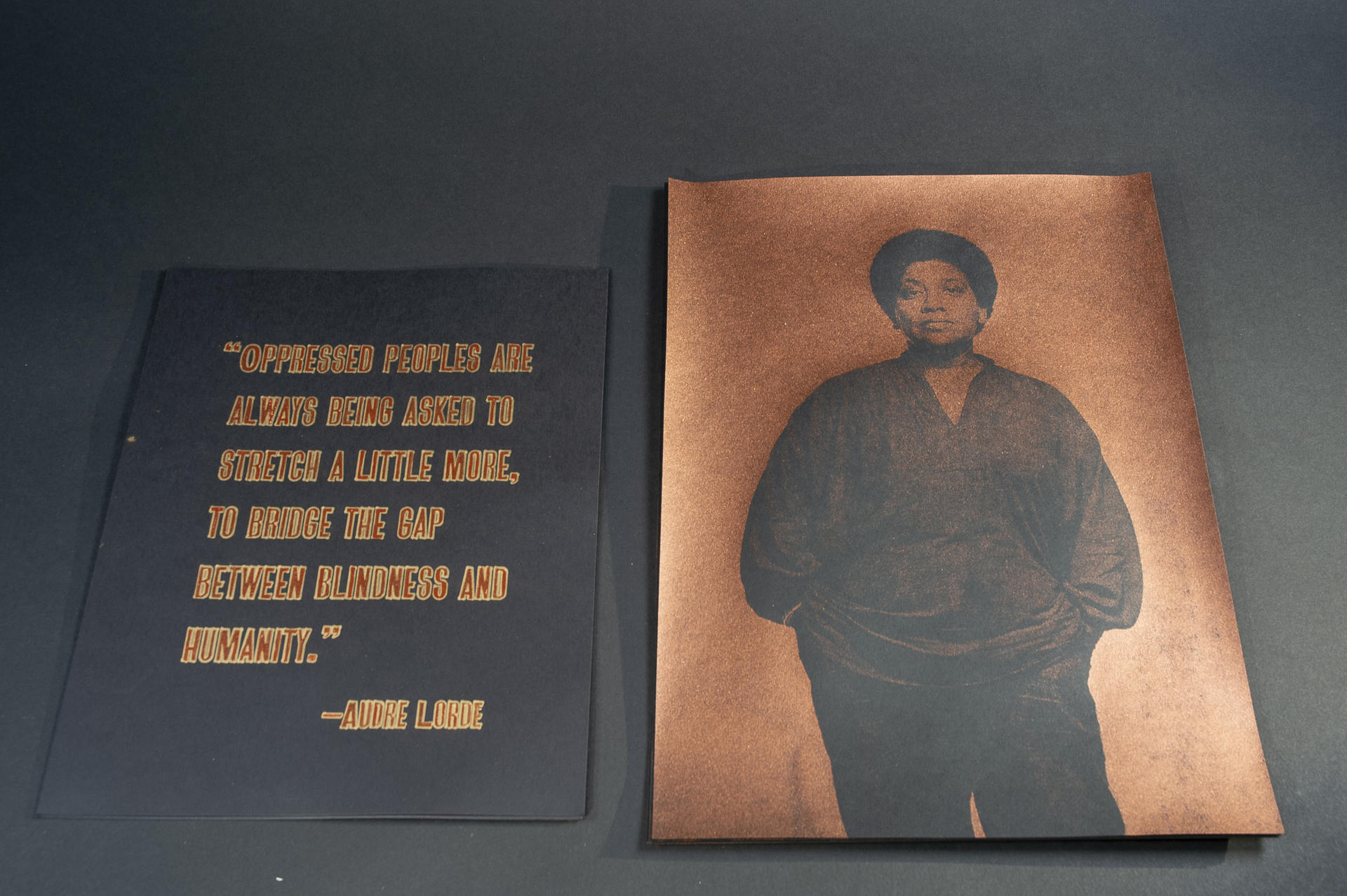
An Incomplete Archive of Capturing [Black]ness
Silkscreen printing, pen plotting, UV printing
2021
The archive can be divided into three broad categories: Historically Overlooked, Modern Day Artists, and Quotes. These categories were then used to systematize the print methods for the items in the archive. Each printing method was based on the connotations and histories embedded in the printing methodology. These methods include Screen Printing, Hand Lettering and UV Printing. Historically overlooked Black trans and Black queer leaders are presented in the archive in the form of copper screen prints, accompanied by handwritten archive tags that illuminate the stories. Quotes by people included in the archive were lettered in a similar bronze paint to that of the silkscreen prints.
Image
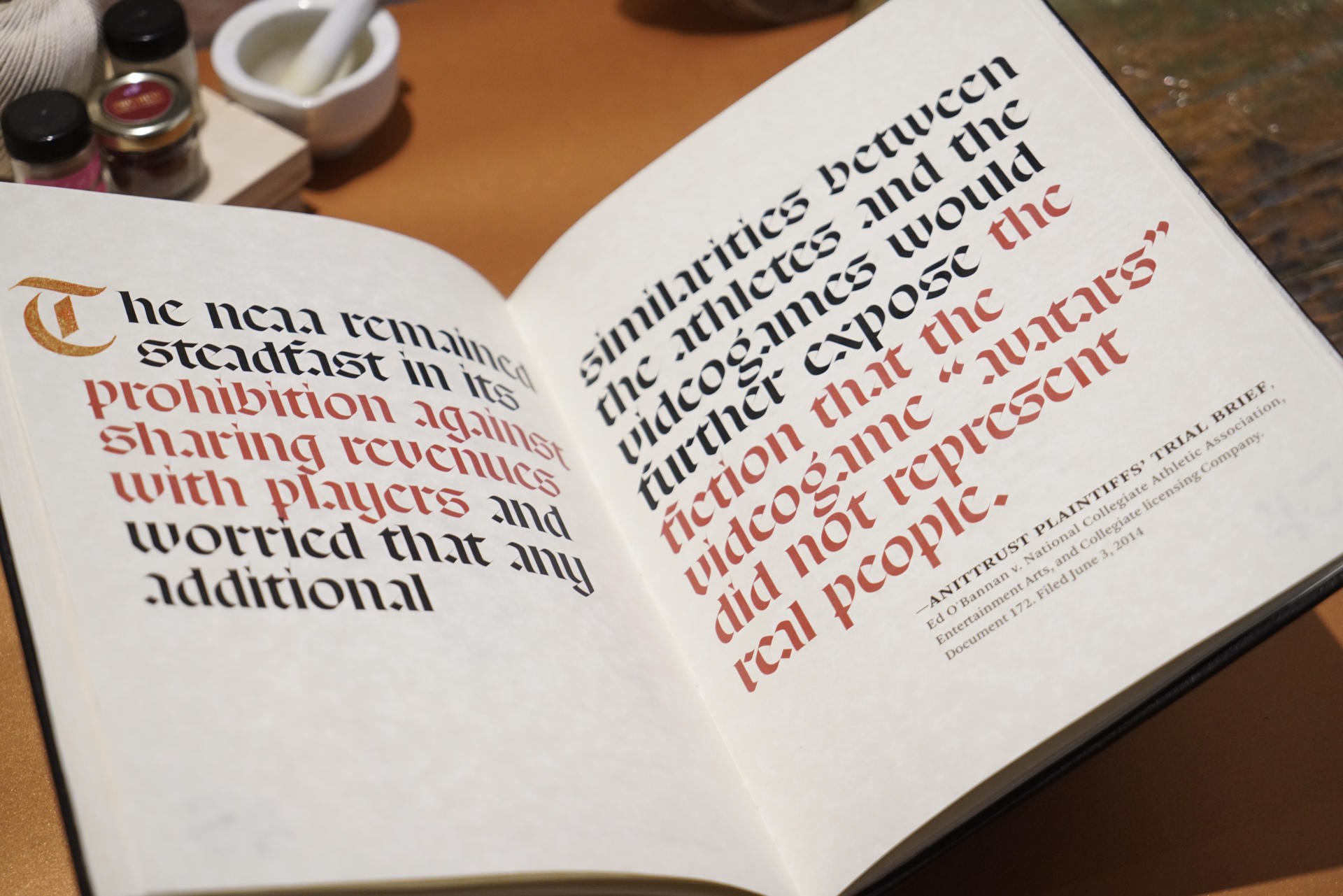
Black Gold
Book
8" x 12"
2022
This started with a quote about Porcelain and Black skin.
With a comment about commodities.
This started with the bone deep knowledge that my body is not viewed as valued,
until a white person deems it valuable. Deems it exotic.
Until a white person recreates it and takes it for themselves.
This book reveals the Alchemical secret of our worth.
And the lengths they'll go to steal it.
In the essay “Cultural reflections on porcelain in the 17th-century Netherlands" Thijs Weststeijn writes “Black people were not infrequently paired with porcelain in Dutch art. Jurriaen van Streeck, for instance, made a series of fulsome works featuring two categories of ‘commodities’ from the Republic’s trade: slaves... and porcelain.” That was the only mention to Black people in the entire essay, but it sent me down a research rabbit hole chasing the commodification of Black likenesses across time and space.
Image
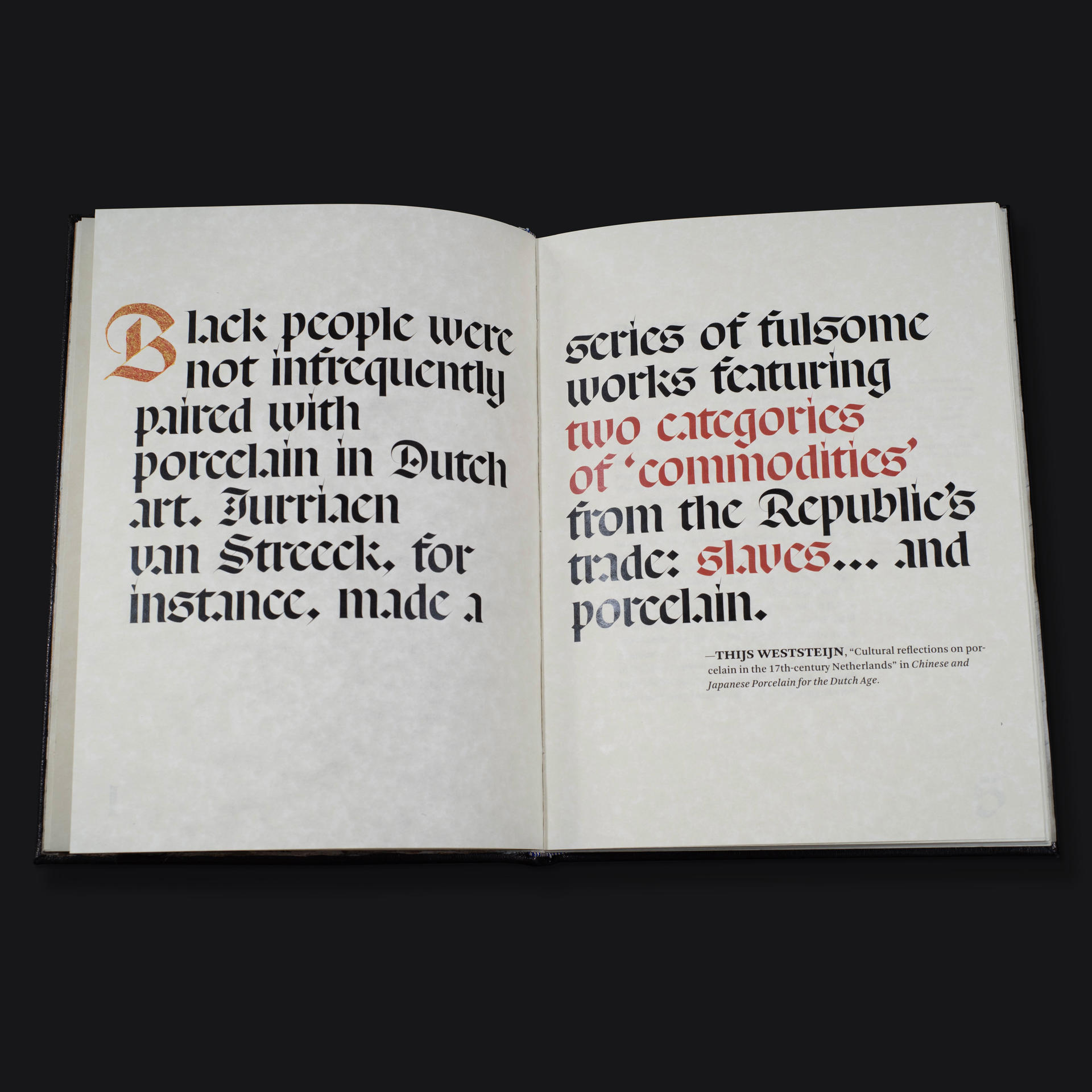
Black Gold
Book
8" x 12"
2022
The book Black Gold is a collection of all my research in the form of an alchemical text. The leather bound tome acts as a compression of time, its medieval form in contrast is its more modern content. Each essay in the book is paired with an alchemical recipe for the synthesis of Black gold. Along with the writing and research, the book contains gold illuminations painted with handmade paints. The “gold” paint used in the book, though an imitation of actual gold, relies on “profitable” materials to create the pigment. The pigment is a mix of mica and brass as the base, which was then blended with saffron threads and powdered diamonds. These last two materials, highly sought after trade commodities in the west, much like Black bodies were in the era of slave trade, have been taking out of their original context and usage to create a deceptive material.
Image
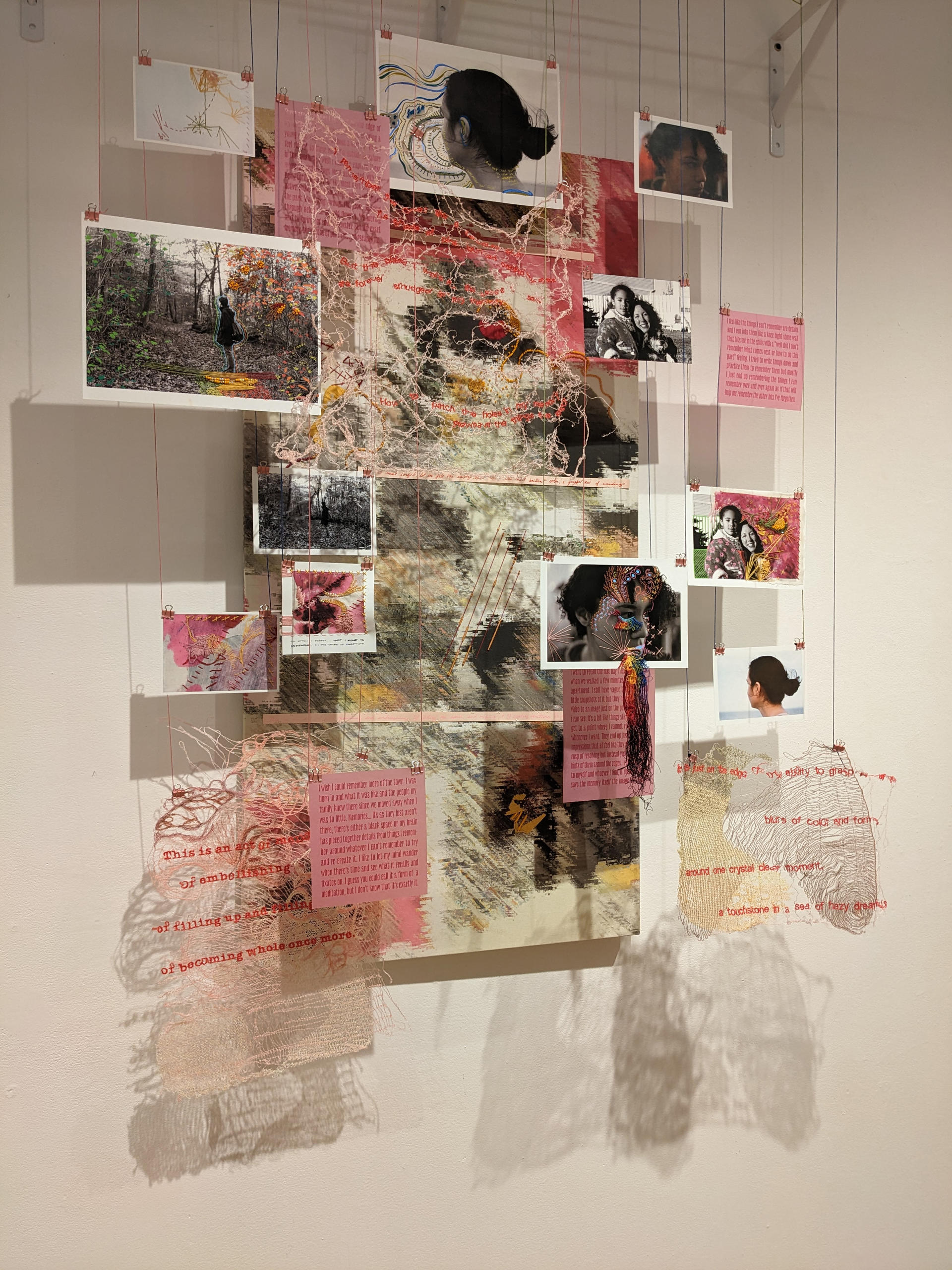
The Space of Memory
Installation
4' x 4'
2022
The Space of Memory was an exploration of the space between memory and reality. It mixes embroidered photos, beading, glitched tapestries, and melted embroideries created on water soluble materials. While on the surface, it asks people to recall the fragments of things they can no longer firmly remember, it also explores the relationship between transness and memory. What is our relationship to memories when others see and remember us so differently from how we understand ourselves? And what is the value of consciously rewriting a memory? Memories slip and our subconscious changes them, making them into stories with their own lives. So what is to stop us from invading the space of memory to remember a version of you that feels more honest? Here memory is presented as a series of branching and twisting threads whose destinations are lost amongst the depths of our minds.
Image
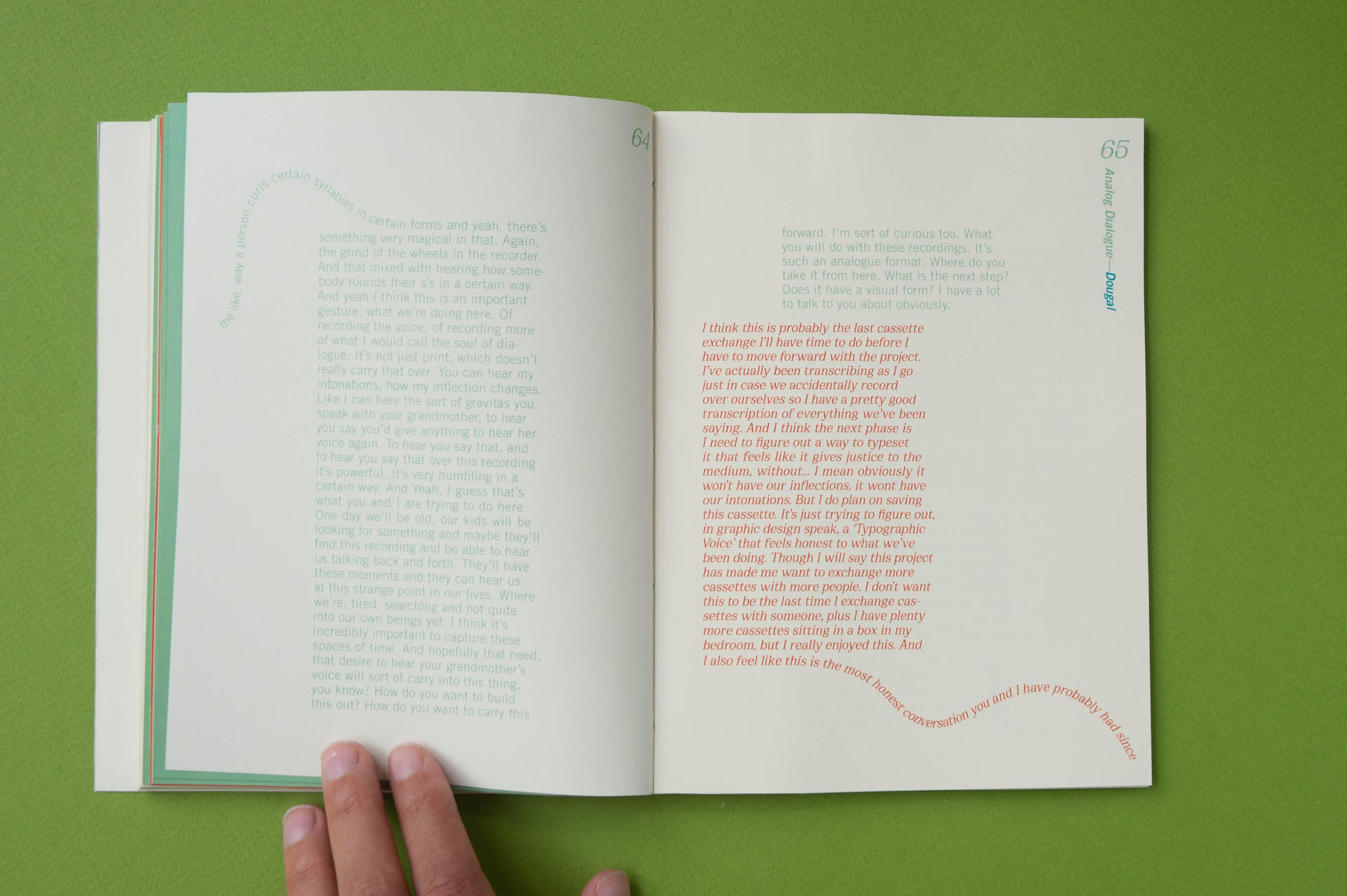
The Number You Are Trying To Reach
Book
2022
The Number You Are Trying To Reach is a book chronicling a 5 months of slow communication and accompanying book of postcards. The goal of the project was to foster slow communication and to give people something to hold on to—written word rather than a collection of code. Following a non-linear format, the book organizes the messy nature of friendship, community, and small moments of joy into a tale that slowly builds through time. Interspersed amongst interviews with friends and letters from strangers are letters from the past, once lost in the mail system.

